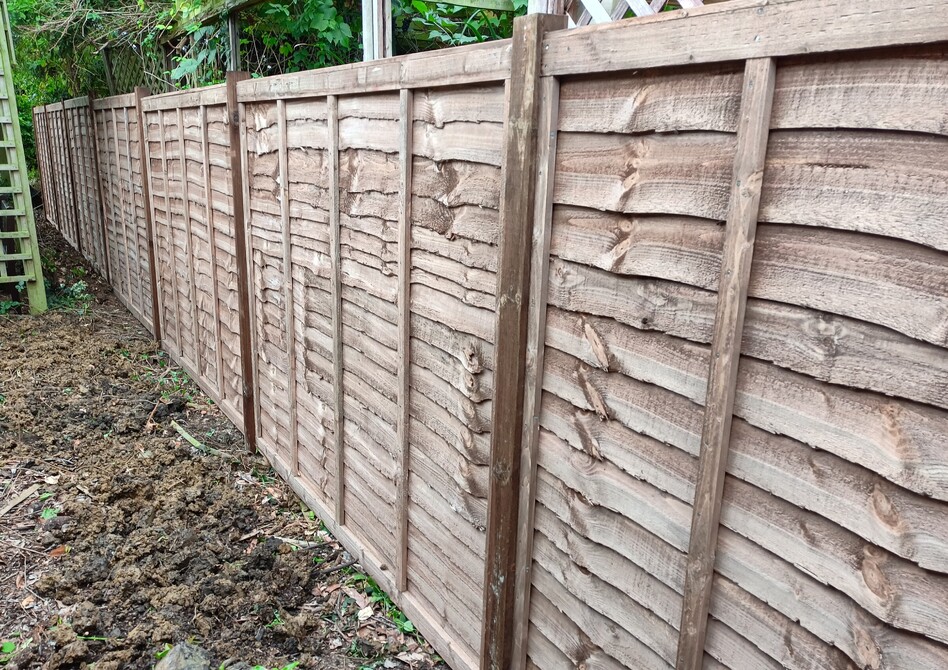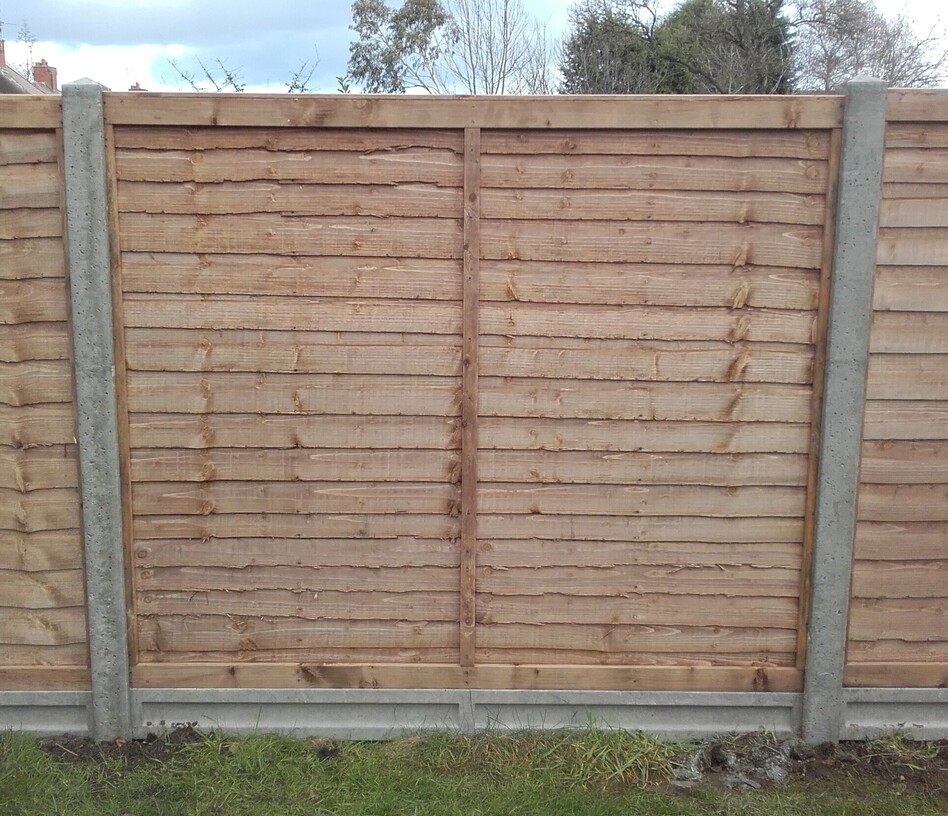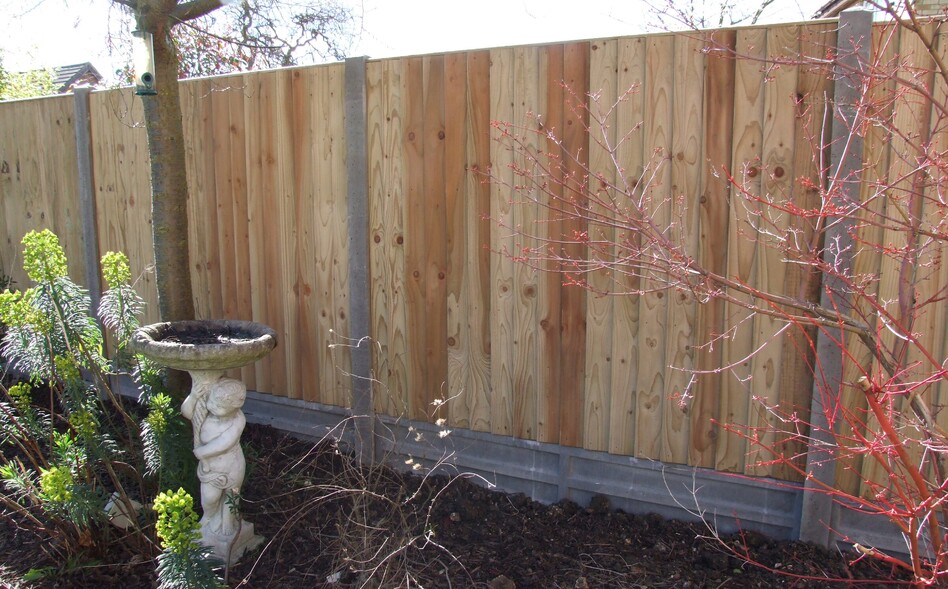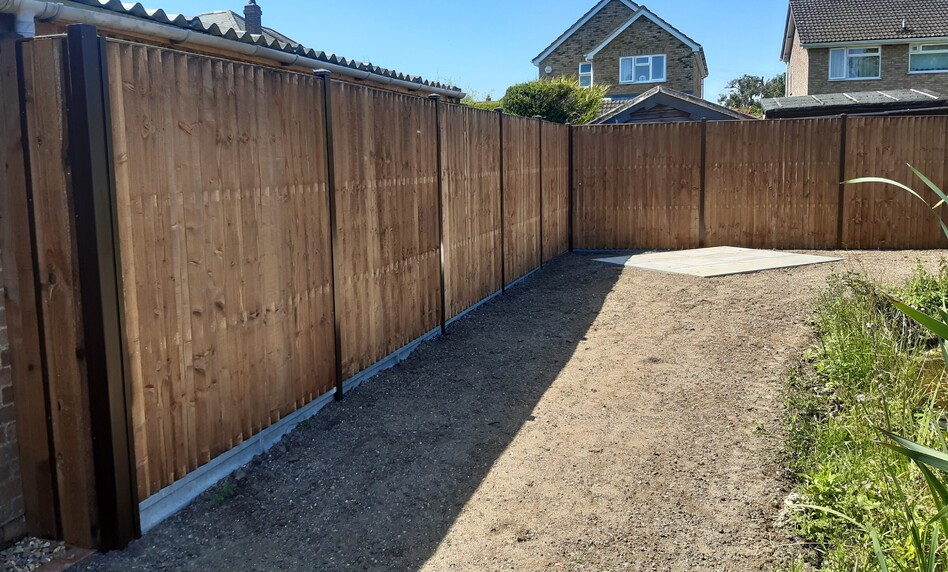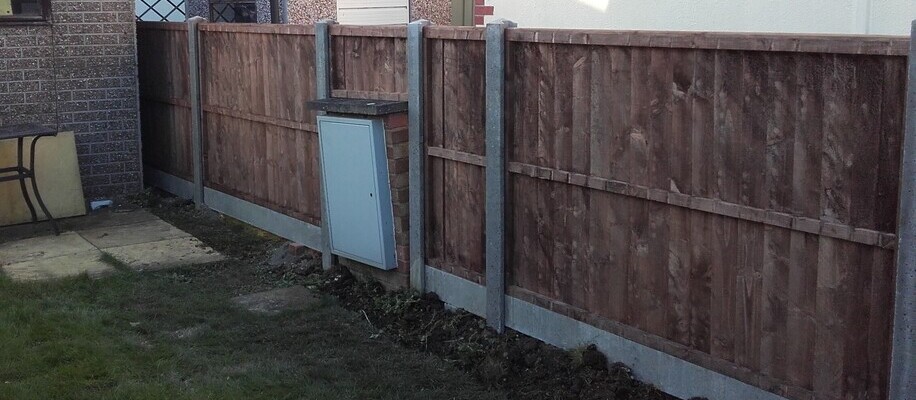Fence panels installed.
Please find below images from previous fence panel installations. These range from standard lap panels fitted to timber posts through to closeboard panels fitted to concrete posts or Durapost. Most boundary fencing will comprise either of lap panels or closeboard panels.
The most economic fencing option is lap panels and timber posts combined. There are many options and variations available. Lap panels can be used in conjunction with slotted concrete posts and concrete gravelboards or used with Durapost components.
Closeboard panels (made from horizontal rails and feather edge boards) are generally considered the strongest option, These can be fitted to timber, slotted concrete and Durapost's.
There are also various other types of panel fencing available in both Timber and Composite materials. It is also possible to source trellis panels to fit with all the post options.
Fencing Panel Guide
What to look for when choosing fence panels.
Traditional UK fencing panels come in various designs and heights but all UK made and supplied fence panels are 6’ long. It is rare to find fencing panels longer than this but I have come across a local manufacturer who once made panels 6’6’ long.
European fence panels:
These are made 180cm long. In layman’s terms this makes them about an inch short of 6’. This is relevant if you decide to retro fit European made fence panels in to previously installed UK fence panel spaces. Just double check the sizing if you are fitting these yourself. When fitting these euro panels into existing fence posts the problem is overcome by the addition of two battens fitted to either end of the fence panel. The fencing supplier should be able to offer these battens to you.
Overlap, Interwoven and Closeboard Fencing Panels:
Traditional styles (and the most common) fencing panels are made from timber and are Overlap, Interwoven or Closeboard types.
Overlap fence panels:
This type is made from waney edged slats that overlap each other and are made up with a batten frame with additional battens to offer strength and to stop the slats from warping. Some fence panel manufacturers will put battens on both the back and front of the panel.
Interwoven fence panels:
These are less common now and are made from fully cut slats (usually about 3” wide) laid horizontally and interwoven around narrow slats that are put through on the vertical. These panels again have a batten frame but may only have a single vertical batten in the center. This type of panel rarely offer fully privacy.
Closeboard fence panels:
These are made up using feather edged boards with heavy batten attached to the back. They should have batten at the top, bottom and both ends and one middle batten for low panels or two equally spaced battens if the panel is over 4’ high.
Premium (European Style) Fence Panels:
At the risk of confusing you these are not always ‘European’ now. I am using the term to relate to the many premium and decorative types of fencing panel that are now available. These are often made up using fully machined and occasionally patterned timber fitted into a framework. These panels have a much higher level of work involved in the manufacturing process and thus usually sell at a premium price.
Choosing Fence Panels:
The two most commonly used panels now are the Overlap fence panel and the Closeboard fence panel. Overlap panels are usually the least expensive panel and Closeboard panels the dearer. Interwoven fence panels are less common than they used to be. The production cost is a lot higher due to increased timber machining and assembly cost. They also offer a little less privacy than the other options as they will open up slightly when the wood shrinks in the drying process.
Installing Fence Panels:
The integrity of any fence is usually in the supporting posts. If these are not installed well and to the appropriate depth the fence will simply fall or blow over when the first high winds come along. Fences up to 6’ high should have fencing posts set into the ground a minimum of two feet deep. So if you have a 6’ fence panel you need an 8’ post.
Fencing Posts:
Fencing panels can be installed on timber, concrete or steel posts. The most economic option would be overlap fence panels fitted to 3” timber posts. The strongest fencing would be Closeboard panels fitted onto concrete gravel boards and slotted concrete posts or steel Durapost.
It is important to realise that wood will go rotten when it gets wet and cannot dry out; this applies to fence posts and timber gravelboards alike. Manufacturers are consistently improving the chemical process for timber treatment. Most commonly found treatment for fencing timber is now Tanatone or Tanalith preservatives.
Fencing Timber:
Most commonly found fencing timber is sourced through correct environmental sources, from managed woodlands and meet all the criteria for FSC certification. The basic problem is that these timber species tend to be fast growing types (required to keep up with demand) and thus have large grain that hold lots of water.
This is OK when the tree is growing and often not problem during the processing. The problem arises when the timber has been machined and assembled and is left to dry out. At this point the timber drys, shrinks and twists and occasionally splits. There is little that can be done to stop this process though often allowing the wood to dry out more slowly and regular treatment with oil or spirit based preservatives will prolong the life and protect your investment.
Timber fencing posts are also subject to occasional warping and splitting as well. This is a natural process and beyond the control of the supplier and installer. Take care when selecting timber posts to ensure they are as straight and contain as few splits as possible when taken from the pile.
Timber Gravel boards for Fencing:
Gravel boards are the bottom board that are designed to protect the fence above from sitting in wet ground or holding back soil or gravel! They are occasionally referred to as kick boards or base boards but 'Gravel board' is the industry norm.
Fencing Gravel boards are available for most types of panel fence system. If you are going to the expense of installing concrete posts and closeboard panels not putting a concrete gravelboard under these does not make any sense. The Gravel board will stop the panel sitting on the floor and will increase the life expectancy of all fence panels.
Durapost Gravel boards:
These are unique in that they are made from a composite material. They are lightweight and will not rot and are available in four colours. More info on Durapost can be found here.
Concrete gravelboards:
These are cast and usually available in different face finishes, recessed is the most common, smooth faced or stone faced are also available. They are usually always grey concrete in colour though! These and the posts can always be painted with exterior masonry paint for aesthetics.
Gravel boards: When fitted correctly gravelboards can do various things. They can hold back soil, provide an edging for a lawn or pathway, they can prevent the panel above from sagging and help prevent water getting to the timber components thus improving the lifespan of the fence. Oh yes, sometimes they actually make the fence look nicer as well!
Mark Brooks Fencing 2014

